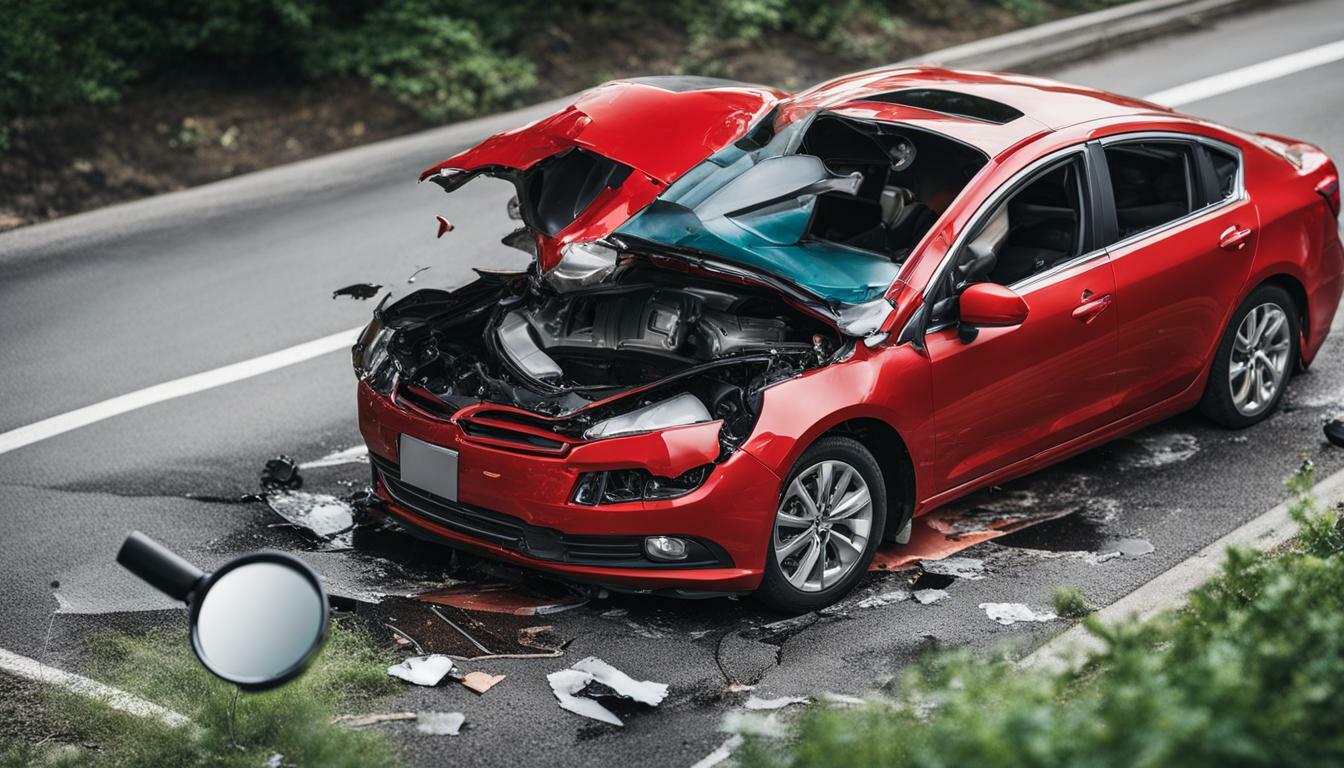Car insurance liability and collision coverage are essential components of any car insurance policy. As a driver, it is important to have a clear understanding of these coverage types to ensure adequate financial protection in case of an accident or damage to your vehicle. In this guide, I will provide you with valuable information on car insurance liability and collision, helping you make informed decisions when purchasing car insurance.
Key Takeaways:
- Car insurance is a transfer of risk, where individuals pay premiums to transfer their risk to an insured group.
- Car insurance coverage types include physical damage coverage like collision and comprehensive insurance.
- Liability insurance is required by law in most states and covers your financial responsibility to others in case of an accident.
- Additional coverage options like medical coverage and uninsured/underinsured motorist protection vary by state.
- Add-ons and riders, such as rental reimbursement and roadside assistance, can enhance your coverage.
Car Insurance Liability and Collision Coverage Types
Car insurance liability and collision coverage can be further categorized into different types of coverage. Physical damage coverage includes collision and comprehensive insurance, which provide financial protection for damages to your vehicle. Collision insurance covers damages resulting from a collision with another vehicle or object, while comprehensive insurance covers damages caused by non-collision events such as theft, vandalism, or natural disasters.
On the other hand, liability insurance is a legal requirement in most states and covers your financial responsibility to others in case of an accident. It includes bodily injury liability, which covers medical expenses, lost wages, and legal fees for injuries caused to others, and property damage liability, which covers the repair or replacement of another person’s property that was damaged as a result of the accident.
In addition to liability and physical damage coverage, there are other optional coverage options available. Medical coverage provides reimbursement for medical expenses for you and your passengers in case of an accident, regardless of fault. Uninsured/underinsured motorist protection covers medical expenses and property damage if you are involved in an accident with a driver who does not have sufficient insurance coverage.
Examples of Car Insurance Liability and Collision Coverage Types:
“Having comprehensive insurance coverage is essential for protecting your vehicle from various non-collision perils, such as hail damage, fire, or theft. It provides peace of mind knowing that you’re financially protected against unexpected events that can cause significant damage to your car.”
Car Insurance Liability and Collision Coverage Types – Summary:
- Physical damage coverage includes collision and comprehensive insurance.
- Liability insurance is a legal requirement and includes bodily injury liability and property damage liability.
- Medical coverage provides reimbursement for medical expenses.
- Uninsured/underinsured motorist protection covers medical expenses and property damage in case of an accident with an insufficiently insured driver.
Understanding these types of coverage can help you make informed decisions when selecting car insurance that meets your needs and provides adequate financial protection.
| Types of Coverage | Explanation |
|---|---|
| Physical Damage Coverage | Includes collision and comprehensive insurance, protecting your vehicle from damages. |
| Liability Insurance | Covers your financial responsibility to others in case of an accident. |
| Medical Coverage | Provides reimbursement for medical expenses for you and your passengers. |
| Uninsured/Underinsured Motorist Protection | Covers medical expenses and property damage in accidents with insufficiently insured drivers. |
Choosing the Right Car Insurance Coverage
Selecting the right car insurance coverage requires considering various factors and understanding the options available. It’s important to assess your needs and preferences to ensure you have the necessary protection in case of an accident or damage to your vehicle. Here are some key considerations to keep in mind when choosing your car insurance coverage:
- Understand state requirements: Each state has minimum requirements for car insurance coverage. It’s essential to familiarize yourself with these requirements to ensure compliance. However, it’s often recommended to opt for coverage limits that exceed the minimum requirements to provide adequate financial protection.
- Consider add-ons and riders: Many insurance companies offer additional coverage options, known as add-ons or riders. These can include rental reimbursement, which covers the cost of renting a replacement vehicle if yours is damaged, and roadside assistance, which provides assistance if your car breaks down. Assess your needs and budget to determine if these add-ons are worth considering.
- Evaluate liability limits: Liability car insurance has limits, which indicate the maximum amount your insurance will pay for different types of claims. It’s crucial to choose liability coverage limits that align with your financial situation and potential risk. Higher limits provide more extensive protection, but they may also come at a higher cost.
Understanding the Cost of Liability Car Insurance
The cost of liability car insurance can vary based on several factors. Insurance companies consider your location, age, driving record, and the coverage amounts you select when determining your premium. For example, living in an area with a high rate of accidents or thefts can increase your premium. Younger drivers or individuals with a history of accidents or traffic violations may also face higher premiums. Additionally, higher coverage amounts will typically result in higher premiums.
It’s essential to strike a balance between adequate coverage and affordability when selecting your car insurance. Comparing quotes from different insurance providers can help you find the best value for your needs. Keep in mind that while price is important, it shouldn’t be the sole determining factor. Ensure that the coverage offered by the insurance company meets your needs and provides the level of protection you require.
| Factors affecting the cost of liability car insurance: | Explanation: |
|---|---|
| Location: | The area you live in can impact your premium based on factors such as crime rates and accident rates. |
| Age: | Youthful drivers often face higher premiums due to their lack of driving experience. |
| Driving record: | Having a history of accidents or traffic violations can increase your premium. |
| Coverage amounts: | Higher coverage limits will typically result in higher premiums. |
By considering these factors and understanding the available options, you can make an informed decision when selecting your car insurance coverage. Remember to review your policy regularly to ensure it continues to meet your evolving needs and provides the necessary protection for your vehicle and financial well-being.
Conclusion
Understanding car insurance liability and collision coverage is crucial for every driver to ensure adequate protection and financial responsibility.
Car insurance serves as a transfer of risk, allowing individuals to transfer their risk to an insured group by paying premiums. These premiums cover the claims for those within the insured group when they experience a loss. Car insurance coverage types include physical damage coverage, such as collision and comprehensive insurance, which provide coverage for damages to your own vehicle.
Liability insurance is a legal requirement in most states and covers your financial responsibility to others in case of an accident. It includes bodily injury liability, which covers medical expenses and lost wages of the other party, and property damage liability, which covers damages to someone else’s property. Additional coverage options, like medical coverage and uninsured/underinsured motorist protection, vary by state.
When purchasing car insurance, it is important to consider add-ons and riders offered by insurance companies, such as rental reimbursement and roadside assistance, to enhance your coverage. It is also essential to choose liability coverage limits above the minimum state requirements to ensure sufficient financial protection in the event of an accident. The cost of liability car insurance varies based on factors like the state you reside in, your age, driving record, and the coverage amounts you select. Understanding these components will help you make informed decisions when selecting a car insurance policy.
FAQ
What is car insurance liability and collision coverage?
Car insurance liability and collision coverage refer to the types of coverage included in a car insurance policy. Liability insurance covers your financial responsibility to others in case of an accident, including bodily injury liability and property damage liability. Collision coverage, on the other hand, covers damages to your own vehicle in case of a collision with another car or object.
Are there any additional coverage options available?
Yes, there are additional coverage options that vary by state and insurance company. Some common add-ons and riders include rental reimbursement, which covers the cost of a rental car while your vehicle is being repaired, and roadside assistance, which provides help in case of a breakdown or other roadside emergencies.
What are liability limits?
Liability car insurance has limits, which indicate the maximum amount the insurance company will pay for different types of claims. These limits are typically represented as three numbers, such as 25/50/25. The first number represents the maximum amount the insurance company will pay per person for bodily injury, the second number represents the maximum amount per accident for bodily injury, and the third number represents the maximum amount for property damage.
Why is it important to choose liability coverage limits above the minimum state requirements?
It is important to choose liability coverage limits above the minimum state requirements to ensure adequate financial protection. Minimum state requirements may not be enough to cover all expenses in case of a major accident. By choosing higher liability coverage limits, you can protect your assets and avoid potential financial hardship.
How is the cost of liability car insurance determined?
The cost of liability car insurance depends on various factors, including the state you live in, your age, driving record, and the amount of coverage you choose. Insurance companies also consider other risk factors, such as the type of car you drive and your credit history. It’s important to shop around and compare quotes from different insurance providers to get the best possible rate.



